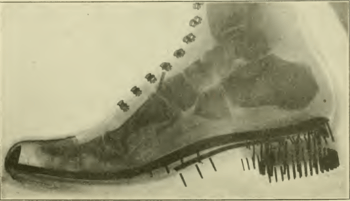High-heeled shoe
High heels are a type of shoe in which the heel, compared with the toe, is significantly higher off the ground. They make the wearer appear taller, accentuating the calf muscle and the length of the leg overall.[1] There are many types of high heels, which come in different styles, colors and materials, and can be found all over the world. They have significant cultural and fashionable meanings attached to them, which have been largely shaped by historical contexts over the past 1,000 years. Wearing high heels is associated with some health problems.
.jpg)
History
Pre-1700s
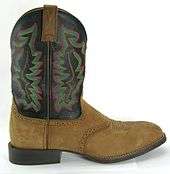
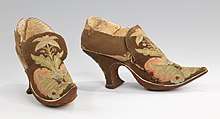
High heels have a long history, dating as far back as the tenth century. The Persian cavalry, for example, wore a kind of boot with heels in order to ensure their feet stayed in the stirrups. Furthermore, research indicates that heels kept arrow-shooting riders, who stood up on galloping horses, safely on the horse.[2] This trend has translated into the popular 21st-century cowboy boot. Owning horses was expensive and time-consuming, so to wear heels implied the wearer had significant wealth.[3] This practical and effective use of the heel has set the standard for most horse-back riding shoes throughout history and even into the present day. Later, in the 12th century in India, heels become visible again. The image of a statue from the Ramappa Temple proves this, showing an Indian woman's foot clad in a raised shoe. Then, during the Medieval period, both men and women wore platform shoes in order to raise themselves out of the trash and excrement filled streets.[4] In 1430, chopines were 30 inches (76 cm) high, at times. Venetian law then limited the height to three inches—but this regulation was widely ignored.[5] A 17th-century law in Massachusetts announced that women would be subjected to the same treatment as witches if they lured men into marriage via the use of high-heeled shoes.[6]
1700s

Modern high heels were brought to Europe by emissaries of Abbas the Great in the early 17th century.[7] Men wore them to imply their upper-class status; only someone who did not have to work could afford, both financially and practically, to wear such extravagant shoes. Royalty such as King Louis XIV wore heels to impart status. As the shoes caught on, and other members of society began donning high heels, elite members ordered their heels to be made even higher to distinguish themselves from lower classes.[8] Authorities even began regulating the length of a high heel's point according to social rank. Klaus Carl includes these lengths in his book Shoes: "½ inch for commoners, 1 inch for the bourgeois, 1 and ½ inches for knights, 2 inches for nobles, and 2 and ½ inches for princes."”[9] As women took to appropriating this style, the heels’ width changed in another fundamental way. Men wore thick heels, while women wore skinny ones. Then, when Enlightenment ideals such as science, nature, and logic took hold of many European societies, men gradually stopped wearing heels.[8] After the French Revolution in the late 1780s, heels, femininity, and superficiality all became intertwined.[3] In this way, heels became much more associated with a woman's supposed sense of impracticality and extravagance.
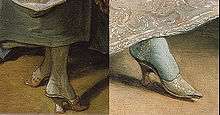
The design of the high French heels from the late 1600s to around the 1720s placed body weight on the ball of the foot, and were decorated with lace or braided fabric (pictured). From the 1730s-1740s, wide heels with an upturned toe and a buckle fastening became popular. The 1750s and 1760s introduced a skinnier, higher heel. The 1790s continued this trend, but added combinations of color. Additionally, throughout all of these decades, there was no difference between the right and left shoe.[10]
In Britain in 1770, an act was introduced into the parliament which would have applied the same penalties as witchcraft to the use of high heels and other cosmetic devices.[11]
1800s

Heels went out of fashion starting around 1810, and then in 1860 they returned at about two and a half inches. The Pinet heel and the Cromwell heel were both introduced during this time.[12] Their production was also increased with the invention and eventual mass production of the sewing machine around the 1850s. With sewing machines, yields increased as machines could quickly and cheaply "position[n] the heel, stitc[h] the upper, and attac[h] the upper to the sole."[9] This is also a prime example of how the popularity of heels interacts with the culture and technology of the time.
1900s
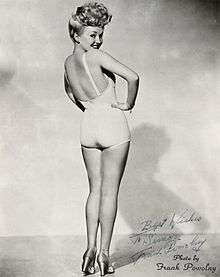
With the 1900s bringing two devastating world wars, many countries set wartime regulations for rationing almost all aspects of life. This included materials previously used for making heels, such as silk, rubber, or leather; these began to be replaced with cork and wooden soles.[13] Another one of the numerous outcomes of these wars was an increase in international relations, and a more proliferate sharing of fashion through photography and films, which helped spread high heel fashion as well.[9] Examples of this were the brown and white pumps with cutouts or ankle straps combined with an open toe.[13] Their practicality yet professional look appealed to the new, fast-paced lifestyle of many women.
Alternatively, World War II led to the popularization of pin-up girl posters, which men would often hang in their bunks while at war. Almost all of these girls were pictured wearing high heels, leading to an increase in the relationship between high heels and female sexuality.[3] The tall, skinny stiletto heel was invented in 1950, strengthening the relationship between women, sexuality, and appearance.[10] There was a weakening of the stiletto style during both the late 1960s / early 1970s and also 1990s when block heels were more prominent, followed by a revival in the 2000s.
21st century
The intricate and complex history of high heels has led to a variety of cultural thoughts and lenses through which people view them today. Firstly, it is very exclusively gendered in the sense that few men wear high heels in present times.[4] Secondly, magazines like Playboy, as well as other media sources portraying women in a sexual way, often do so using high heels. Paul Morris, a psychology researcher at the University of Portsmouth, argues that high heels accentuate "sex specific aspects of female gait", artificially increasing a woman's femininity.[4] Respectively, the arching of a woman's back facilitated by wearing high heels signals a woman's willingness to be courted by a man.[14][15] Keeping this sexual undercurrent in mind, heels are considered fashionable for women in most cases. It could be semi-formal with a "button down silk blouse…jeans and high heels."[16] Or, it could be formal with a dress or pants suit. Finally, 20th and 21st century cultural values have dictated that high heels are the norm in professional settings for a woman. Some researchers argue that high heels have even become part of the female workplace uniform, and operate in a much larger and complex set of display rules.[4] High heels are considered to pose a dilemma to women as they bring them psychosexual benefits but are detrimental to their health.[17] The 21st century has introduced a broad spectrum and variety of styles, ranging from height and width of heel, to design and color of the shoe.
Types
- Stacked heel – usually layers of leather 5 mm thick stacked together and trimmed to match the shape of the heel.[1] These are commonly known as block heels.
- Continental heel – 7.5 mm, with the upper part of the chest of the heel spreading towards the center of the shoe.[1]
- Setback heel – similar to the continental heel, but the surface of the back of the heel is straight, forming a right angle.[1]
- Cuban heel – similar to the continental heel, but not curved, generally medium height[1]
- Pantaloon heel – "similar to pantaloon pants: the top lift part of the heel is spread out as it extends to the bottom part of the heel, and the waistline of the heel curves inward naturally."[1]
- Angle heel – "the surface of the base of the heel is straight until reaching the waistline, and it looks like the shape of the Korean letter ¬"[1]
- Pinet heel – straight and skinny[12]
- Cromwell shoe – based on Oliver Cromwell with heel up to 170 mm (6.5 in).[12]
- Bar Style – had jewelry or other decorative aspects to go along with flapper culture.[12]
- New Look in 1947 – a slim/elegant heel, newly discovered by putting steel in the heel. This enabled the heel to be ultra skinny without snapping.[12]
- Annabelle – 7 cm platform heel[18]
- Stiletto – Tall, skinny heel; first mentioned in a newspaper in September 1953.[12]
- Wedges - These were popularized by Salvatore Ferragamo, who introduced this in the Italian market in the late 1930s.
Materials
High heels have been made from all kinds of materials throughout history. In the early years, leather and cowhide was preferred. As civilizations progressed, silk and patent leather were introduced, while cork and wood were utilized as cheap resources in times of war.[13] After the World Wars and the increase in production of steel, the actual heel was a piece of steel wrapped in some kind of material. This has enabled designers to make heels taller and skinnier without them snapping.[19] The soles below the ball of the foot of Ballroom shoes can also be made of materials like smooth leather, suede, or plastic. [20]
Health impacts

Injury and pain
Wearing high-heeled shoes is strongly associated with injury, including injury requiring hospital care. There is evidence that high-heel-wearers fall more often, especially with heels >2.5cm high,[21] even if they were not wearing high heels at the time of the fall.[22] Wearing high heels is also associated with musculoskeletal pain,[22] specifically pain in the paraspinal muscles (muscles running up the back along the spine) and specifically with heel pain and plantar calluses (only women tested).[21]
A 2001 survey conducted by researchers from Pennsylvania State University using 200 women found that 58% of women complained of lower back pain when wearing heels and 55% of women said they felt the worst overall back pain when wearing the highest heel.[23] The researchers explained that as heel height increases, the body is forced to take on an unnatural posture to maintain its center of gravity. This changed position places more pressure and tension on the lower lumbar spine which explains why the women complained of severe back pain at a higher heel length.
In a 1992 study, researchers from the University of California, Davis and Thomas Jefferson University wanted to investigate the effects of increased heel height on foot pressure using forty-five female participants walking across a pressure plate in various heel heights.[24] A Biokinetics software was used to analyze the exact pressure locations on and along each participants' foot. The researchers were able to conclude that an increase in heel height lead to an increase in pressure beneath each of the Metatarsal bones of the foot. Additionally, they found that the highest heel heights caused constant pressure that could not be evenly dispersed across the foot.
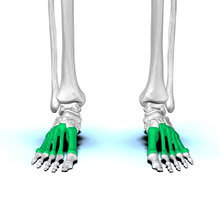
In a 2012 study, Kai-Yu Ho, Mark Blanchette and Christopher Powers, wanted to determine if heel height increased patellofemoral joint stress during walking.[25] The patellofemoral joint refers to junction where the femur and patella meet. The study consisted of eleven participants wearing tracking and reflective markers as they walked across a 10-meter force plated walkway in low, medium and high heels. The study showed that as the height of the heel increased, the ball of the foot experienced an increase in pressure resulting in increased discomfort levels and peak patellofemoral joint stress. The researchers also mentioned that the long term usage of high heels would lead to repetitive overstress of the joint which would result in an increase in pain and eventually, patellofemoral joint osteoarthritis and Patellofemoral pain syndrome.
In a 2012 study, researchers examined the risk long time high heel wearers would have in regards to calf Muscle fascicle length and strain.[26] The control group consisted of women who wore heels for less than ten hours weekly and the experimental group consisted of women who wore heels for a minimum of forty hours weekly for at least two years. The experimental group was told to walk down a walkway barefoot and in heels while the control group walked down barefoot as cameras recorded their movements to calculate muscle fascicle lengths. The data showed that wearing heels shortened the length of the medial gastrocnemius (MG) muscle fascicles in the calf significantly as well as increasing stiffness in the Achilles Tendon. The experimental group also demonstrated a larger amount of strain on the muscle fascicles while walking in heels because of the flexed position the foot is forced into. The researchers were able to estimate that when wearing heels, the estimated fascicle strains were approximately three times higher and the fascicle strain rate was approximately six times higher. Additionally, they were able to conclude that the long term usage of high heels can increase the risk of injuries such as strain along with discomfort and muscle fatigue.
Bunions
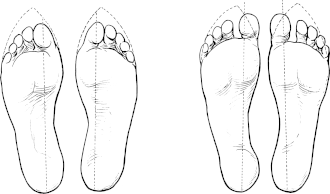
Wearing high-heeled shoes is associated with developing bunions, a deformity of the foot.[22][21]
Balance control of the body
In 2016, scientists from the Department of Physical Therapy in the Sahmyook University in Korea conducted a study to examine the effects of increased heel height and gait velocity on balance control.[28] Balance control refers to the ability of the body to maintain itself along the line of the center of gravity within a base of support. This must be achieved with minimal postural sway velocity which is the horizontal movement of a body trying to maintain balance when standing still. Wearing high heels narrows the base of support that the body has in order to avoid falling and also restricts the area within which the body must sway. In this study, the participants were told to wear either a low or high heel and walk at a low and high speed on a treadmill. As a result of this experiment, the researchers were able to conclude that as heel height increased, the sway velocity of the bodies increased which also modified the position of the knee joint. Muscles have to realign the entire body especially the hips along the line of gravity. As the weight of the body shifted forward, the hips were taken out of alignment and the knee joints experienced stress in order to adjust to the shift.
Postural effects
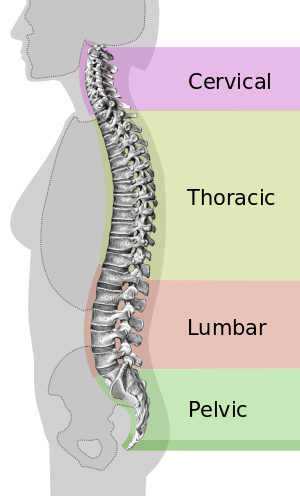
In a 2016 study from the Sahmyook University in Korea, researchers wanted to investigate the effects of high heels on the activation of muscles in the cervical and lumbar portions of the spine which refers to the neck and lower back.[29] Thirteen women were recruited to walk down a walkway in three different testing conditions: barefoot, in 4 cm heels and in 10 cm heels. Surface electrodes were placed on the muscle mass of the women's spines as well as their feet to measure the electrical activity of muscles at different points of movement. The results of the study indicated an increase in both cervical and lumbar muscle activation as heel height increased. The cervical spine, the neck, assists in maintaining head stability and postural control in the body. The usage of high heels shifts the body's center of mass which forces the spine to adjust itself in order to maintain balance. The researchers mentioned that over time these results would increase local muscle fatigue that could lead to muscle swelling, decreased muscle movement and even tissue deformation.
Vein swelling
Further research reveals that another possible consequence of wearing high heels is an increase of pressure in one's veins. Experiments have proven that the higher the heel, the "higher [the] venous pressure in the leg." This means that after repeated use of high heels, varicose veins and other undesirable symptoms are much more likely to appear in the legs.[18] Other research supports these two claims when arguing that wearing high heels can lead to numerous long term effects, including accidental trauma to multiple areas of the body.[4]
Legislation
In Carmel-by-the-sea, California, heels over 2 inches high, with less than one square inch of bearing surface, can be worn only with a permit.[30]
It has been argued that high heels in the workplace should be subject to a health and safety assessment.[31]
Feminism
Research shows that heels draw attention to long legs and small feet. Some argue that "high-heeled shoes, perhaps more than any other item of clothing, are seen as the ultimate symbol of being a woman."[12] High heels often play a key role in emphasizing a wearer's, most commonly a woman's, arched back and extended buttocks. This "natural courting pose" sexualizes the wearer, and can turn them into objects subjected to the male gaze.[2] This research highlights the emphasis heels place on the appearance of the wearer, instead of their arguably more valuable internal traits such as intelligence, creativity, or strength.
It has not been popular for men to wear high heels since the late 18th century.[3] Some men see the cultural norm, which often mandates that women must wear heels to look professional, as completely unproblematic.[32] However, women report that they are often painful to walk in,[1] and commonly result in negative side effects to joints and veins after prolonged use.[18]
At the feminist Miss America protest in 1968, protestors symbolically threw a number of feminine products into a "Freedom Trash Can." These included high-heels,[33] which were among items the protestors called "instruments of female torture"[34] and accouterments of what they perceived to be enforced femininity.
In 2015, a group of women were turned away from a film première at the Cannes Film Festival in France for wearing flat shoes, including a woman physically unable to wear heels due to an operation on one of her feet.[35] The women complained that this was a sexist policy which forced women into a stereotyped appearance; festival organisers later responded that there was no official policy on footwear and stated that they would remind red carpet officials of this.[9][36]
Dress codes
Some dress codes require women to wear high heels, and some medical organizations have called for a ban on such dress codes.[22] There have been repeated protests by women workers against such policies. Laws regarding dress codes that require women to wear high heels in the workplace vary.
In the UK in 2016 temporary receptionist Nicola Thorp was sent home unpaid after she refused to follow the dress code of firm Portico. Thorp launched an online petition calling for the UK government to "make it illegal for a company to require women to wear high heels at work".[37] Two parliamentary committees in January 2017 decided that Portico had broken the law; by this time the company had already changed its terms of employment.[38][39] The petition was rejected by the government in April 2017 as they stated that existing legislation was "adequate".[40] Existing legislation allows women to be required to wear high heels, but only if it is considered a job requirement and men in the same job are required to dress to an "equivalent level of smartness".[41]
In April 2017 the Canadian province of British Columbia amended workplace legislation to prevent employers from requiring women to wear high heels at work.[42] Other Canadian provinces followed suit.[43]
The Philippines forbade companies from mandating that female employees wear high heels at work in September 2017.[44]
The #KuToo campaign in Japan collected over 150,000 signatures on a petition[45] for a ban on mandatory high heels. The government said that they had no plans to change.[46] Japan's labor minister commented that high heels are "necessary and appropriate" for women.[47]
A Mile in Her Shoes
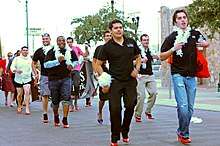
A Mile in Her Shoes is a march in which men wear red high heels and walk a mile in protest of domestic violence. Some academics have suggested that by wearing high heels for such a brief period of time, and making a point of acting like they do not know how to walk properly in them, these men are reinforcing the stereotype that only women can or should wear high heels.[48]
Children
.jpg)
High heels are marketed to children, and some schools encourage children to wear them.[22] 18% of injuries from wearing high heels were in children, and 4% in under-tens, in a 2002-2012 US survey.[22] Concern was expressed about children's use of high heels in a 2016 medical review on high-heeled shoes.[22] A nine-year old is about half an adult's height, and a toddler about a quarter; so, relative to body height, a 2-inch (5 cm) heel on an adult would be a one-inch heel on the nine-year-old, and a half-inch heel on the toddler,[27] though whether this translates to comparable health harms is not known.[22]
Dancing
Styles of Dance that use Heels
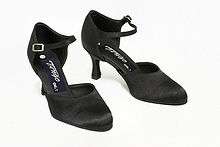
Many styles of dance involve the usage of heels. Ballroom dancing shoes are designed for usage based on the style of dance being performed. International Standard Ballroom shoes for women are closed toed shoes with a 2 to 2.5 inch sturdy heel because steps are performed using the heel of the foot.[49] International Latin and American Rhythm shoes are open toed, strapped heels that are an average of 2.5 to 3 inches in height. These shoes have the least-sturdy heel because International Latin and American Rhythm styles are performed on the ball of the foot. Additionally, this style of shoe is designed with a flexible sole to allow for pointed feet. Lastly, American Smooth shoes are closed toed, flexible soled shoes that range in heel height from 2 to 2.5 inches. An additional non-traditional ballroom dance that uses heels is the Argentine Tango. While dancing the Argentine Tango, women often wear pointed heels ranging in 2 to 4 inches in height.[20] The higher the heel height, the more advanced in technique and ability a dancer is. The heels are used to change the overall stance of the woman by tilting the hips forward, making the stomach flatter and pushing the backside out. Additionally, the heels cause unsteadiness which forces women to dance on their toes and lean on their partner which adds to the fluidity of the movements. A relatively modern style of dance called Heels Choreography or Stiletto dance specializes in choreography that blends the styles of jazz, hip-hop and burlesque with the fusion of vogue movements and is performed using stilettos or high heels.[50] Some dancers such as Yanis Marshall specialize in dancing with high-heels.[51]
Injuries
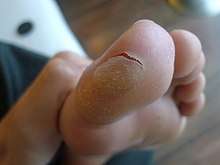
An analysis of the dance-related injuries in 113,084 adolescents in US emergency rooms from 1991–2007 was conducted using data from the National Electronic Injury Surveillance System.[52] The most common injury found among the data were sprains and strains which accounted for 52.4% of the data. Additional injuries include back and leg pain, loss of joint mobility in the wearer's knees and blisters. In particular, shoes with a narrow space for the toes can squeeze tightly enough to cause foot deformity.[53] Dancers can add cushioning to the soles of their dancing shoes or inserts to ease the pain during dancing.[20]
See also
- Desert boots
- Elevator shoes
- Fashion boots
- Foot binding
- High heel policy
- Insolia
- Locomotor effects of shoes
- Platform boots
- Pointed shoe (disambiguation)
- Removable heel
- Riding boots
- Thigh-high boots
References
- Han, Dongwook. "Muscle Activation of Paraspinal Muscles in Different Types of High Heels during Standing." Journal of Physical Therapy Science, vol. 27, no. 1, 2015, pp. 67–9., doi:10.1589/jpts.27.67.
- Kremer, William. "Why did Men Stop Wearing High Heels?" BBC World Service. 26 Jan 2013.
- Trufelman, Avery. "Feet of Engineering." 99% Invisible. Jun 2014.
- Morris, Paul; Jenny White; Edward Morrison; Kayleigh Fisher (May 2013). "High Heels are Supernormal Stimuli: How Wearing High Heels Affects Judgments of Female Attractiveness". Evolution and Human Behavior. 34 (3): 176–181. doi:10.1016/j.evolhumbehav.2012.11.006.
- Margo DeMello (2009). Feet and Footwear: A Cultural Encyclopedia. Greenwood Press/ABC-CLIO. p. 311. ISBN 978-0-313-35714-5.
- Margo DeMello (10 September 2009). Feet and Footwear: A Cultural Encyclopedia. ABC-CLIO. p. 323. ISBN 978-0-313-35715-2.
- Kremer, William (25 January 2013). "Why did men stop wearing high heels?". bbc.com. BBC. Retrieved 20 June 2018.
- Wade, Lisa. "From Manly to Sexy: The History of the High Heel" The Society Pages. 5 Feb 2013.
- Carl, Klaus. Shoes. New York, Parkstone International, 2011. EbscoHost.
- Blanco F José, et al., editors. Clothing and Fashion : American Fashion from Head to Toe. Santa Barbara, California, ABC-CLIO, an Imprint of ABC-CLIO, LLC, 2016. Print.
- John Brookes (1859), Manners and Customs of the English Nation, James Blackwood, pp. 261–262,
In the year 1770 an act was introduced into Parliament against hoops, false hair, high heels...
- Shawcross, Rebecca. "High Heels." The Berg Companion to Fashion. Ed. Valarie Steele. Oxford: Bloomsbury Academic, 2010. Web.
- Stabb, Jo Ann. "The Early 20th Century Through World War II" Clothing and Fashion: American Fashion from Head to Toe, edited by Jose Blanco, vol. 3 ABC-CLIO, pp. 330-332. Gale Virtual Reference Library.
- Elizabeth Hawkins (25 October 2017). "Why arched backs are attractive". springer.com.
- Pazhoohi, F.; Doyle, J.F.; Macedo, A.F.; Arantes, J. (2017). "Arching the Back (Lumbar Curvature) as a Female Sexual Proceptivity Signal: an Eye-Tracking Study". Evolutionary Psychological Science. 4 (2): 1–8. doi:10.1007/s40806-017-0123-7.
- "Women's Dress and Fashion, 1980-Present" Clothing and Fashion: American Fashion from Head to Toe, edited by Jose Blanco, vol. 4 ABC-CLIO, pp. 321-325. Gale Virtual Reference Library.
- Barnish M, Morgan HM, Barnish J (2018). "The 2016 HIGh Heels: Health effects And psychosexual BenefITS (HIGH HABITS) study: systematic review of reviews and additional primary studies". BMC Public Health (Review). 18 (1): 37. doi:10.1186/s12889-017-4573-4. PMC 5537921. PMID 28760147.
- Filho, Wagner, Nei Dezzotti, Edvaldo Joviliano, Takachi Moriya, Carlos Piccinato. "Influence of High-Heeled Shoes on Venous Function in Young Women." Journal of Vascular Surgery, vol. 56, Oct 2012.
- Schwartz, Jessica. "Stiletto Heels." Clothing and Fashion: American Fashion from Head to Toe, edited by Jose Blanco, vol. 4: The Postwar Period into the 21st century, ABC-CLIO, pp. 281-282. Gale Virtual Reference Library.
- Littig, Beate (2013). "On high heels: A praxiography of doing Argentine tango". European Journal of Women's Studies. 20 (4): 455–467. doi:10.1177/1350506813496397. ISSN 1350-5068.
- Jellema, AH; Huysmans, T; Hartholt, K; van der Cammen, TJM (September 2019). "Shoe design for older adults: Evidence from a systematic review on the elements of optimal footwear". Maturitas. 127: 64–81. doi:10.1016/j.maturitas.2019.06.002. PMID 31351522.
- Barnish, MS; Barnish, J (13 January 2016). "High-heeled shoes and musculoskeletal injuries: a narrative systematic review". BMJ Open. 6 (1): e010053. doi:10.1136/bmjopen-2015-010053. PMC 4735171. PMID 26769789.
- Lee, Chang-Min; Jeong, Eun-Hee; Freivalds, Andris (2001). "Biomechanical effects of wearing high-heeled shoes". International Journal of Industrial Ergonomics. 28 (6): 321–326. doi:10.1016/s0169-8141(01)00038-5. ISSN 0169-8141.
- Snow, Rebecca E.; Williams, Keith R.; Holmes, George B. (1992). "The Effects of Wearing High Heeled Shoes on Pedal Pressure in Women". Foot & Ankle. 13 (2): 85–92. doi:10.1177/107110079201300206. ISSN 0198-0211. PMID 1572591.
- Ho, Kai-Yu; Blanchette, Mark G.; Powers, Christopher M. (2012). "The influence of heel height on patellofemoral joint kinetics during walking". Gait & Posture. 36 (2): 271–275. doi:10.1016/j.gaitpost.2012.03.008. ISSN 0966-6362. PMID 22520457.
- Cronin, Neil J.; Barrett, Rod S.; Carty, Christopher P. (15 March 2012). "Long-term use of high-heeled shoes alters the neuromechanics of human walking". Journal of Applied Physiology. 112 (6): 1054–1058. doi:10.1152/japplphysiol.01402.2011. ISSN 8750-7587. PMID 22241055.
- Rossi, William A. (February 2001). "Footwear: The Primary Cause of Foot Disorders" (PDF).
- Jang, Il-Yong; Kang, Da-Haeng; Jeon, Jae-Keun; Jun, Hyun-Ju; Lee, Joon-Hee (2016). "The effects of shoe heel height and gait velocity on position sense of the knee joint and balance". Journal of Physical Therapy Science. 28 (9): 2482–2485. doi:10.1589/jpts.28.2482. ISSN 0915-5287. PMC 5080157. PMID 27799675.
- Park, Kisu; Kim, Young; Chung, Yijung; Hwang, Sujin (2016). "Effects of the height of shoe heels on muscle activation of cervical and lumbar spine in healthy women". Journal of Physical Therapy Science. 28 (3): 956–959. doi:10.1589/jpts.28.956. ISSN 0915-5287. PMC 4842473. PMID 27134392.
- Bell, Diane (11 September 2014). "Carmel high heel ban makes Ripley's". San Diego Union-Tribune.
- "High heels 'should be banned at work'". Archived from the original on 23 September 2009. Retrieved 14 November 2019.
- Reynaud, Bérénice. "These Shoes Are Made for Walking." Afterall: A Journal of Art, Context and Enquiry, no. 6, pp. 42–51. 2002.
- Dow, Bonnie J. (Spring 2003). "Feminism, Miss America, and Media Mythology". Rhetoric & Public Affairs. 6 (1): 127–149. doi:10.1353/rap.2003.0028.
- Duffett, Judith (October 1968). WLM vs. Miss America. Voice of the Women's Liberation Movement. p. 4.
- "Emily Blunt on Cannes heels row: 'everybody should wear flats'". The Telegraph. 19 May 2015. Retrieved 16 May 2016.
- "Cannes denies high-heel rule for women on red carpet". www.yahoo.com. Retrieved 16 May 2016.
- Johnston, Chris (12 May 2016). "Woman's high-heel petition receives 100,000-plus signatures". the Guardian. Retrieved 13 May 2016.
- McIntosh, Lindsay (16 May 2016). "Heel-loving Sturgeon steps into shoe debate". The Times. London. Retrieved 7 March 2017. (subscription required)
- Bilefsky, Dan (6 March 2017). "British Woman's Revolt Against High Heels Becomes a Cause in Parliament". The New York Times. Retrieved 7 March 2017.
- "High heels row: Petition for work dress code law rejected". BBC News. 21 April 2017. Retrieved 21 April 2017.
- Yorke, Harr (21 April 2017). "Employers can force women to wear high heels as Government rejects campaign to ban the practice". The Telegraph.
- Collig, Pádraig (8 April 2017). "Canadian province makes it illegal to require women to wear high heels". The Guardian. Retrieved 8 April 2017.
- "Alberta takes steps to ban mandatory high heels in the workplace | National Post". National Post. 30 November 2018. Retrieved 11 November 2019.
- Yi, Beh Lih (25 September 2017). "Philippines bans mandatory high heels at work". Reuters. Retrieved 29 July 2019.
- "#KuToo no more! Japanese women take stand against high heels". Reuters. 6 June 2019. Retrieved 29 October 2019.
- Hollingsworth, Julia (4 June 2019). "Japanese women revolt against high heel requirements". CNN Style.
- High heels at work are necessary, says Japan's labour minister The Guardian, 2019
- Bridges, Tristan. "Men Just Weren't Made to do This: Performances of Drag at 'Walk a Mile in Her Shoes' Marches." Gender and Society, vol. 24, no. 1, 2010, pp. 5–30. JSTOR.
- "Ballroom Guide - Shoe Guide Page 1 What are Dance Shoes?". www.ballroomguide.com. Retrieved 19 March 2019.
- "Dance Centre Myway - Стили / Heels". mywaydance.com. Retrieved 1 March 2019.
- YANIS MARSHALL (28 December 2015). "Yanis Marshall - The Choreographer - Zumanity: Rated Cirque - Ep. 1- Cirque Du Soleil" – via YouTube.
- Roberts, Kristin J.; Nelson, Nicolas G.; McKenzie, Lara (2013). "Dance-Related Injuries in Children and Adolescents Treated in US Emergency Departments in 1991−2007". Journal of Physical Activity and Health. 10 (2): 143–150. doi:10.1123/jpah.10.2.143. ISSN 1543-3080. PMID 22820836.
- Han, Dongwook (2015). "Muscle activation of paraspinal muscles in different types of high heels during standing". Journal of Physical Therapy Science. 27 (1): 67–69. doi:10.1589/jpts.27.67. ISSN 0915-5287. PMC 4305600. PMID 25642040.
External links
![]()
